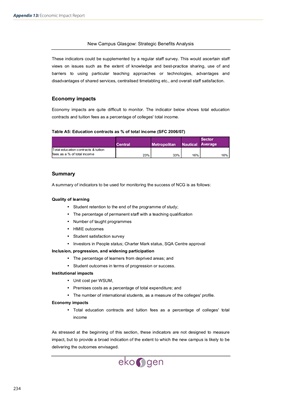
New Campus Glasgow: Strategic Benefits Analysis
These indicators could be supplemented by a regular staff survey. This would ascertain staff
views on issues such as the extent of knowledge and best-practice sharing, use of and
barriers to using particular teaching approaches or technologies, advantages and
disadvantages of shared services, centralised timetabling etc., and overall staff satisfaction.
Economy impacts
Economy impacts are quite difficult to monitor. The indicator below shows total education
contracts and tuition fees as a percentage of colleges' total income.
Table A5: Education contracts as % of total income (SFC 2006/07)
Central Metropolitan Nautical Sector
Average
Total education contracts & tuition
fees as a % of total income 23% 33% 16% 16%
Summary
A summary of indicators to be used for monitoring the success of NCG is as follows:
Quality of learning
• Student retention to the end of the programme of study;
• The percentage of permanent staff with a teaching qualification
• Number of taught programmes
• HMIE outcomes
• Student satisfaction survey
• Investors in People status; Charter Mark status, SQA Centre approval
Inclusion, progression, and widening participation
• The percentage of learners from deprived areas; and
• Student outcomes in terms of progression or success.
Institutional impacts
• Unit cost per WSUM,
• Premises costs as a percentage of total expenditure; and
• The number of international students, as a measure of the colleges' profile.
Economy impacts
• Total education contracts and tuition fees as a percentage of colleges' total
income
As stressed at the beginning of this section, these indicators are not designed to measure
impact, but to provide a broad indication of the extent to which the new campus is likely to be
delivering the outcomes envisaged.
234
Appendix 13: Economic Impact Report